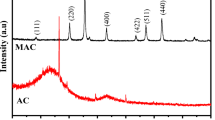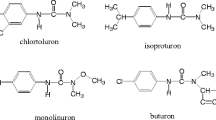Abstract
Solid-phase extraction (SPE) on activated carbon derived from coconut shell (CSAC) for the preconcentration of four varying polarity pesticides (imidacloprid, acetamiprid, simazine, and linuron) prior to their determination using high performance liquid chromatography with diode array detector (HPLC-DAD) was investigated. The characteristics of the CSAC were analyzed through X-ray diffraction (XRD), scanning electron microscopy (SEM), Fourier transform infrared spectroscopy (FT-IR), and Brunauer-Emmett-Teller (BET) method. The effects of the solution pH, eluent type, eluent volume, and flow rate were investigated for optimization of the presented procedure. The adsorption was achieved quantitatively on the CSAC column in the pH range of 2.0–7.0, and then the retained pesticides were eluted with dichloromethane. The detection limit was found to be 0.025–0.039 μg L−1, depending on the pesticide. The proposed SPE-CSAC method was used to determine selected pesticides in tap water samples. The recoveries ranged from 58.2 to 105.3%, with low relative standard deviations. The obtained results indicated that the CSAC could be efficiently used as a low cost alternative to commercially available SPE adsorbents for the determination of the varying polarity pesticides in environmental water samples at trace levels.








Similar content being viewed by others
References
Ajmal, M., Rao, R. A. K., Ahmad, R., & Ahmad, J. (2000). Adsorption studies on Citrus reticulata (fruit peel of orange): removal and recovery of Ni(II) from electroplating wastewater. Journal of Hazardous Materials, 79, 117–131.
Al-Degs, Y. S., & Al-Ghouti, M. A. (2008). Preconcentration and determination of high leachable pesticides residues in water using solid-phase extraction coupled with high-performance liquid chromatography. International Journal of Environmental Analytical Chemistry, 88, 487–498.
Anirudhan, T. S., & Sreekumari, S. S. (2011). Adsorptive removal of heavy metal ions from industrial effluents using activated carbon derived from waste coconut buttons. Journal of Environmental Sciences, 23, 1989–1998.
Bello, O. S., & Ahmad, M. A. (2012). Coconut (Cocos nucifera) shell based activated carbon for the removal of malachite green dye from aqueous solutions. Separation Science and Technology, 47, 903–912.
Carabias-Martínez, R., García-Hermida, C., Rodríguez-Gonzalo, E., & Ruano-Miguel, L. (2005). Behaviour of carbamate pesticides in gas chromatography and their determination with solid-phase extraction and solid-phase microextraction as preconcentration steps. Journal of Separation Science, 28, 2130–2138.
Chen, J., & Zhu, X. (2015). Ionic liquid coated magnetic core/shell Fe3O4@SiO2 nanoparticles for the separation/analysis of linuron in food samples. Spectrochimica Acta A, 137, 456–462.
Dolas, H., Sahin, O., Saka, C., & Demir, H. (2011). A new method on producing high surface area activated carbon: the effect of salt on the surface area and the pore size distribution of activated carbon prepared from pistachio shell. Chemical Engineering Journal, 166, 191–197.
Dujaković, N., Grujić, S., Radišić, M., Vasiljević, T., & Laušević, M. (2010). Determination of pesticides in surface and ground waters by liquid chromatography–electrospray–tandem mass spectrometry. Analytica Chimica Acta, 678, 63–72.
Gregg, S. J., & Sing, K. S. W. (1967). Adsorption, Surface Area and Porosity. London: Academic Press.
Guedidi, H., Reinert, L., Soneda, Y., Bellakhal, N., & Duclaux, L. (2017). Adsorption of ibuprofen from aqueous solution on chemically surface-modified activated carbon cloths. Arabian Journal of Chemistry, 10, S3584–S3594.
Gurgel, L. V. A., & Gil, L. F. (2009). Adsorption of Cu(II), Cd(II) and Pb(II) from aqueous single metal solutions by succinylated twice-mercerized sugarcane bagasse functionalized with triethylenetetramine. Water Research, 43, 4479–4488.
Hassan, A. F., Mortada, W. I., & Hassanien, M. M. (2013). Preparation and characterization of activated carbon based rice husk and its use for preconcentration of Pt (II). International Journal of Modern Chemistry, 5, 101–117.
Korrani, Z. S., Ibrahim, W. A. W., Nodeh, H. R., Aboul-Enein, H. Y., & Sanagi, M. M. (2016). Simultaneous preconcentration of polar and non-polar organophosphorus pesticides from water samples by using a new sorbent based on mesoporous silica. Journal of Separation Science, 39, 1144–1151.
Lambropoulou, D. A., & Albanis, T. A. (2007). Methods of sample preparation for determination of pesticide residues in food matrices by chromatography-mass spectrometry-based techniques: a review. Analytical and Bioanalytical Chemistry, 389, 1663–1683.
Li, M., Wang, J., Jiao, C., Wang, C., Wu, Q., & Wang, Z. (2016). Graphene oxide framework: an adsorbent for solid phase extraction of phenylurea herbicides from water and celery samples. Journal Chromatography A, 1469, 17–24.
Lippens, B. C., Linsen, B. G., & de Boer, J. H. (1964). Studies on pore systems in catalysts I. The adsorption of nitrogen; apparatus and calculation. Journal of Catalysis, 3, 32–37.
Marcilla, A., Beltrán, M. I., & Navarro, R. (2006). TG/FT-IR analysis of HZSM5 and HUSY deactivation during the catalytic pyrolysis of polyethylene. Journal of Analytical and Applied Pyrolysis, 76, 222–229.
Meseguer-Lloret, S., Torres-Cartas, S., Catalá-Icardo, M., Simó-Alfonso, E. F., & Herrero-Martínez, J. M. (2017). Extraction and preconcentration of organophosphorus pesticides in water by using a polymethacrylate-based sorbent modified with magnetic nanoparticles. Analytical and Bioanalytical Chemistry, 409, 3561–3571.
Moussavi, G., Hosseini, H., & Alahabadi, A. (2013). The investigation of diazinon pesticide removal from contaminated water by adsorption onto NH4Cl-induced activated carbon. Chemical Engineering Journal, 214, 172–179.
Órfão, J. J. M., Silva, A. I. M., Pereira, J. C. V., Barata, S. A., Fonseca, I. M., Faria, P. C. C., & Pereira, M. F. R. (2006). Adsorption of a reactive dye on chemically modified activated carbons—influence of pH. Journal of Colloid and Interface Science, 296, 480–489.
Pan, B., & Xing, B. (2008). Adsorption mechanisms of organic chemicals on carbon nanotubes. Environmental Science and Technology, 42, 9005–9013.
Ravelo-Pérez, L. M., Hernández-Borges, J., & Rodríguez-Delgado, M. Á. (2008). Multiwalled carbon nanotubes as solid-phase extraction materials for the gas chromatographic determination of organophosphorus pesticides in waters. Journal of Separation Science, 31, 3612–3619.
Rozaini, M. N. H., Yahaya, N., Saad, B., Kamaruzaman, S., & Hanapi, N. S. M. (2017). Rapid ultrasound assisted emulsification micro-solid phase extraction based on molecularly imprinted polymer for HPLC-DAD determination of bisphenol A in aqueous matrices. Talanta, 171, 242–249.
Saha, B., Harry, I. D., & Siddiqui, U. (2009). Electrochemically modified viscose-rayon-based activated carbon cloth for competitive and noncompetitive sorption of trace cobalt and lead ions from aqueous solution. Separation Science and Technology, 44, 3950–3972.
Sankararamakrishnan, N., Sharma, A. K., & Sanghi, R. (2005). Organochlorine and organophosphorous pesticide residues in ground water and surface waters of Kanpur, Uttar Pradesh, India. Environment International, 31, 113–120.
Short, M. A., & Walker, P. L. (1963). Measurement of interlayer spacings and crystal sizes in turbostratic carbons. Carbon, 1, 3–9.
Sing, K. (2001). The use of nitrogen adsorption for the characterisation of porous materials. Colloids and Surfaces A, 187-188, 3–9.
Song, C., Wu, S., Cheng, M., Tao, P., Shao, M., & Gao, G. (2014). Adsorption studies of coconut shell carbons prepared by KOH activation for removal of lead(II) from aqueous solutions. Sustainability, 6, 86–98.
Taghani, A., Goudarzi, N., & Bagherian, G. (2016). Application of multiwalled carbon nanotubes for the preconcentration and determination of organochlorine pesticides in water samples by gas chromatography with mass spectrometry. Journal of Separation Science, 39, 4219–4226.
Taghani, A., Goudarzi, N., Bagherian, G. A., Chamjangali, M. A., & Amin, A. H. (2018). Application of nanoperlite as a new natural sorbent in the preconcentration of three organophosphorus pesticides by microextraction in packed syringe coupled with gas chromatography and mass spectrometry. Journal of Separation Science, 41, 2245–2252.
Tahboub, Y. R., Zaater, M. F., & Al-Talla, Z. A. (2005). Determination of the limits of identification and quantitation of selected organochlorine and organophosphorous pesticide residues in surface water by full-scan gas chromatography/mass spectrometry. Journal of Chromatography A, 1098, 150–155.
Tankiewicz, M., Fenik, J., & Biziuk, M. (2010). Determination of organophosphorus and organonitrogen pesticides in water samples. Trends in Analytical Chemistry, 29, 1050–1063.
Trtić-Petrović, T., Đorđević, J., Dujaković, N., Kumrić, K., Vasiljević, T., & Laušević, M. (2010). Determination of selected pesticides in environmental water by employing liquid-phase microextraction and liquid chromatography–tandem mass spectrometry. Analytical and Bioanalytical Chemistry, 397, 2233–2243.
Tzeng, S. S., Hung, K. H., & Ko, T. H. (2006). Growth of carbon nanofibers on activated carbon fiber fabrics. Carbon, 44, 859–865.
Villaverde, J. J., Sevilla-Morán, B., López-Goti, C., Alonso-Prados, J. L., & Sandín-España, P. (2016). Trends in analysis of pesticide residues to fulfil the European Regulation (EC) no. 1107/2009. Trends in Analytical Chemistry, 80, 568–580.
Vukčević, M., Kalijadis, A., Radišić, M., Pejić, B., Kostić, M., Laušević, Z., & Laušević, M. (2012). Application of carbonized hemp fibers as a new solid-phase extraction sorbent for analysis of pesticides in water samples. Chemical Engineering Journal, 211-212, 224–232.
Wang, P., Luo, M., Liu, D., Zhan, J., Liu, X., Wang, F., Zhou, Z., & Wang, P. (2018). Application of a magnetic graphene nanocomposite for organophosphorus pesticide extraction in environmental water samples. Journal of Chromatography A, 1535, 9–16.
Zhang, J., & Lee, H. K. (2006). Application of liquid-phase microextraction and on-column derivatization combined with gas chromatography–mass spectrometry to the determination of carbamate pesticides. Journal of Chromatography A, 1117, 31–37.
Zheng, W., & Liu, W. (1999). Kinetics and mechanism of the hydrolysis of imidacloprid. Pesticide Science, 55, 482–485.
Zhou, Q., Ding, Y., & Xiao, J. (2006). Sensitive determination of thiamethoxam, imidacloprid and acetamiprid in environmental water samples with solid-phase extraction packed with multiwalled carbon nanotubes prior to high-performance liquid chromatography. Analytical and Bioanalytical Chemistry, 385, 1520–1525.
Zhou, Q., Ding, Y., & Xiao, J. (2007). Simultaneous determination of cyanazine, chlorotoluron and chlorbenzuron in environmental water samples with SPE multiwalled carbon nanotubes and LC. Chromatographia, 65, 25–30.
Funding
We acknowledge the support to this work provided by the Ministry of Education, Science and Technological Development of Serbia through the projects No. III 45006, III45012 and III 43009.
Author information
Authors and Affiliations
Corresponding author
Ethics declarations
Conflict of Interest
The authors declare that they have no conflict of interest.
Additional information
Publisher’s Note
Springer Nature remains neutral with regard to jurisdictional claims in published maps and institutional affiliations.
Rights and permissions
About this article
Cite this article
Kumrić, K., Vujasin, R., Egerić, M. et al. Coconut Shell Activated Carbon as Solid-Phase Extraction Adsorbent for Preconcentration of Selected Pesticides from Water Samples. Water Air Soil Pollut 230, 302 (2019). https://doi.org/10.1007/s11270-019-4359-7
Received:
Accepted:
Published:
DOI: https://doi.org/10.1007/s11270-019-4359-7




